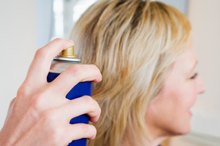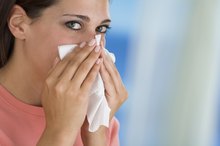How to Treat a Reaction to Sunscreen
Sunscreen is necessary to avoid the sun's harmful rays, but if you are sensitive to creams and lotions, wearing it may be difficult. If you experience redness, swelling and/or blisters just minutes or even days after applying it, you may be experiencing contact dermatitis (the term meaning a skin reaction to a substance). If the reaction is severe, call a doctor immediately. But there are a few things you can do for instant treatment.
Cleanse
Remove any traces of the sunscreen. Wash your body with a mild cleanser and water. Use a washcloth to gently wash the sunscreen off your skin. Do not harshly rub, as this will only cause further irritation.
Allergy to Cardboard
Learn More
Lightly and gently apply a hydrocortisone cream, which is available at your local drugstore. This will help calm the skin down and take away some of the redness.
Call a dermatologist for further testing. Be sure to bring in the product with you. He can check to see which substances you are allergic to through various allergy testing materials. It may be that you are allergic to the fragrances or dyes found within that particular sunscreen 1.
Tips
If you find yourself with a reaction to sunscreen, be sure to look for ingredients such as benzophenone 4, 4-aminobenzoic acid, 2-ethylhexyl-4-dimethylaminobenzoate, Para-Aminobenzoic Acid (PABA), and Arlatone UVB on any bottle of sunscreen. These are substances which can cause an allergic reaction. Look for sunscreens that contain only titanium dioxide and zinc oxide. They work better for those with sensitive skin. Read product labels carefully. The best manner to treat contact dermatitis is avoidance. Test a small amount of sunscreen before you rub it all over your body. Rub a small amount of the sunscreen on the back of your arm and leave it on for 48 hours. Then, check to see if any reaction has occurred. If so, discontinue the use of the product.
Warnings
As always, avoid prolonged periods of sun and always use an SPF of at least 25. Do not use a reaction as a reason not to put on sunscreen. See a dermatologist to discuss your options.
- Remove any traces of the sunscreen.
- Use a washcloth to gently wash the sunscreen off your skin.
Related Articles
References
- Auckland Allergy Clinic: Sunscreen Allergy Information
- Glogau Dermatology. Glogau wrinkle scale.
- Grabel A. Photoaging: what you need to know about the other kind of aging. Skin Cancer Foundation. Published January 10, 2019.
- D'Orazio J, Jarrett S, Amaro-Ortiz A, Scott T. UV radiation and the skin. Int J Mol Sci. 2013;14(6):12222‐12248. doi:10.3390/ijms140612222
- Burke KE, Wei H. Synergistic damage by UVA radiation and pollutants. Toxicol Ind Health. 2009;25(4-5):219‐224. doi:10.1177/0748233709106067
- Jariashvili K, Madhan B, Brodsky B, Kuchava A, Namicheishvili L, Metreveli N. UV damage of collagen: insights from model collagen peptides. Biopolymers. 2012;97(3):189‐198. doi:10.1002/bip.21725
- Bernstein EF, Sarkas HW, Boland P, Bouche D. Beyond sun protection factor: An approach to environmental protection with novel mineral coatings in a vehicle containing a blend of skincare ingredients. J Cosmet Dermatol. 2020;19(2):407‐415. doi:10.1111/jocd.13007
- Xu S, Kwa M, Agarwal A, Rademaker A, Kundu RV. Sunscreen product performance and other determinants of consumer preferences. JAMA Dermatol. 2016;152(8):920-7. doi:10.1001/jamadermatol.2016.2344
- Diffey BL. When should sunscreen be reapplied? J Am Acad Dermatol. 2001;45(6):882‐885. doi:10.1067/mjd.2001.117385
- Murphy ME, Montemarano AD, Debboun M, Gupta R. The effect of sunscreen on the efficacy of insect repellent: a clinical trial. J Am Acad Dermatol. 2000;43(2 Pt 1):219‐222. doi:10.1067/mjd.2000.107960
Writer Bio
Jennifer Purdie is a freelance writer who has been published in national and regional publications for more than 10 years. She is a certified personal trainer who speaks and writes on fitness, health, travel and lifestyle issues. Purdie received her bachelor's degree in English from the University of Washington, her master's degree from the University of Phoenix and a publishing certification from Arizona State University.









